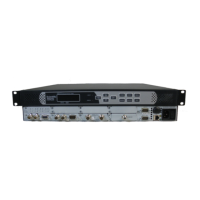Audio Setup
There are three primary modes of audio down mix operation for the MPEG-
2/MPEG-4 4:2:0 decoders (1 Video, 2 Audio). These settings only affect the signal if
the digital output is set to "PCM." It will also affect those embedded audio channels
that are set to a PCM down mix.
The modes are "Monitor" (the default setting), "Transmission", and "User."
Note: There are no gain changes if the digital or embedded outputs are set to Raw.
The first mode is "Transmission." It allows no changes by the customer. It is intended
to provide a limited dynamic range signal to drive a set-top box or a transmitter. The
"Transmission" mode does respond to dialog normalization data. It provides a gain
boost of 11 dB and has compression to prevent the signal from overdriving a
modulator. The 11 dB gain boost is applied to the analog outputs, AES digital
outputs set to PCM, and any embedded outputs set to PCM.
Note: It will not affect the gain of digital outputs or embedded outputs set to Raw.
It is intended to provide a similar audio level as a broadcast TV station signal
through an RF modulator. The down mix includes the "center" and "surround"
channels if they are present, and is represented as Lt/Rt. (left total/right total)
The second mode is "Monitor." It has moderate processing, no gain boost and its
down mix involves left and right channels only (L/R). The compression setting is
"Line" mode as the default, but may be changed to "RF", "Custom 0", or "Custom 1."
In "Line" mode, the Dolby dialog normalization data is followed. No other
parameters may be set by the customer. It is intended for monitoring of sources with
only some peak limiting protection. Selecting "RF" as the compression setting will
add 11 dB of gain and the same processing as the "Transmission" mode to the analog
outputs, AES digital outputs set to PCM, and any embedded outputs set to PCM.
The down mix is L/R (left only/right only).
The third mode available is "User." It allows all parameters to be set by the operator.
The compression choices are "RF", "Line Mode", "Custom 0", and "Custom 1." RF and
"Line Mode" essentially duplicate the first two modes of audio mix down described
above. The "Custom 0" and "Custom 1" modes have no audio processing or gain
boost. "Custom 1" does enable gain changes called for by the dialog normalization
data. It allows the operator to enable or disable the dynamic range (peak limiting)
and select the channels to downmix "Lt/Rt", "L/R", "Auto", "Mono L", and "Mono
R". Mono left or Mono right applies that signal to both left and right channels of the
digital service, left and right channels of the analog outputs, and left and right
channels of any embedded stream set to PCM. "Auto" was introduced with Dolby
Digital Plus and will select the downmix of Lt/Rt or L/R based on the received
audio metadata. If the metadata is not present or Dolby Digital audio is received,
Lt/Rt down mixing is used.

